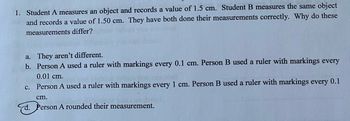
Chemistry
10th Edition
ISBN: 9781305957404
Author: Steven S. Zumdahl, Susan A. Zumdahl, Donald J. DeCoste
Publisher: Cengage Learning
expand_more
expand_more
format_list_bulleted
Concept explainers
Question
thumb_up100%
Student A measures an object and records a value of 1.5 cm. Student B measures the same object and records a value of 1.50 cm. They have both done their measurements correctly. Why do these measurements differ?

Transcribed Image Text:### Measurement Accuracy and Precision
In this example, we examine the measurements taken by two students to understand the concepts of accuracy and precision in measurement:
**Problem Statement:**
1. **Scenario:**
- Student A measures an object and records a value of 1.5 cm.
- Student B measures the same object and records a value of 1.50 cm.
Both students have performed their measurements correctly. Why do these measurements differ?
**Multiple Choice Answers:**
a. They aren't different.
b. Person A used a ruler with markings every 0.1 cm. Person B used a ruler with markings every 0.01 cm.
c. Person A used a ruler with markings every 1 cm. Person B used a ruler with markings every 0.1 cm.
d. Person A rounded their measurement.
**Correct Answer:**
d. Person A rounded their measurement.
### Explanation:
The difference in measurements arises from how the precision of the measurements is recorded:
- **Student A's Measurement (1.5 cm):**
- Rounded measurement.
- Indicates that the measurement was rounded to the nearest tenth of a centimeter (0.1 cm).
- **Student B's Measurement (1.50 cm):**
- More precise.
- Measurement is to the nearest hundredth of a centimeter (0.01 cm).
In science and engineering, the precision of a measurement often includes all known digits plus one estimated digit. Hence, it's essential to be aware of the precision and accuracy of the instruments being used and to record measurements accordingly.
Expert Solution
This question has been solved!
Explore an expertly crafted, step-by-step solution for a thorough understanding of key concepts.
This is a popular solution
Trending nowThis is a popular solution!
Step by stepSolved in 3 steps

Knowledge Booster
Learn more about
Need a deep-dive on the concept behind this application? Look no further. Learn more about this topic, chemistry and related others by exploring similar questions and additional content below.Similar questions
- 1. What is the length of the rod shown below? 3 4 7 10 2. If Student A measures the volume of a liquid and reports its volume as 23.50 mL and Student B measures a different amount of the same liquid and reports its volume as 15.0 mL, is it likely that the students used the same measuring device? Yes or no? Explain your answer. 3. If you were asked to measure 25.0 mL of a liquid and to transfer it to another container, which of the following glassware could you use? Choose all that apply. Give reason(s). a) A 50-mL buret with smallest divisions of 0.1 mL b) A 50 mL beaker with smallest divisions of 10 mL c) A 50-mL volumetric flask d) A 50-mL graduated cylinder with smallest divisions of 1 mL e) A 25-mL pipet 4. A group of five students attempted to estimate 100 g of a substance by balancing the amount of the substance with a 100-g standard mass and obtained the following masses after each estimated amount was weighed: 95.8634 g, 80.8125 g, 106.5078 98.2865 and 86.4453 Create a data…arrow_forwardNot sure what I am doing wrong here...arrow_forwardI measured a line that was 8.4 centimeters which is the same as 3.375 inches. How do I calculate the percente relative error?arrow_forward
- What is the best description of precision as applied to a set of measurements or data? Select one: The difference between the maximum and minimum values of a data set O The total number of data points in a data set O How well data points within a data set agree with each other O How well the average of a data set agrees with a known valuearrow_forward1. Why are units so important in measurement? Giving examples of measurements with no units should help. 2. What does it mean to say that 2 expressions are equivalent?arrow_forwardRecord the volume of the liquid in the graduated cylinder to the correct number of significant figures.arrow_forward
arrow_back_ios
arrow_forward_ios
Recommended textbooks for you
 ChemistryChemistryISBN:9781305957404Author:Steven S. Zumdahl, Susan A. Zumdahl, Donald J. DeCostePublisher:Cengage Learning
ChemistryChemistryISBN:9781305957404Author:Steven S. Zumdahl, Susan A. Zumdahl, Donald J. DeCostePublisher:Cengage Learning ChemistryChemistryISBN:9781259911156Author:Raymond Chang Dr., Jason Overby ProfessorPublisher:McGraw-Hill Education
ChemistryChemistryISBN:9781259911156Author:Raymond Chang Dr., Jason Overby ProfessorPublisher:McGraw-Hill Education Principles of Instrumental AnalysisChemistryISBN:9781305577213Author:Douglas A. Skoog, F. James Holler, Stanley R. CrouchPublisher:Cengage Learning
Principles of Instrumental AnalysisChemistryISBN:9781305577213Author:Douglas A. Skoog, F. James Holler, Stanley R. CrouchPublisher:Cengage Learning Organic ChemistryChemistryISBN:9780078021558Author:Janice Gorzynski Smith Dr.Publisher:McGraw-Hill Education
Organic ChemistryChemistryISBN:9780078021558Author:Janice Gorzynski Smith Dr.Publisher:McGraw-Hill Education Chemistry: Principles and ReactionsChemistryISBN:9781305079373Author:William L. Masterton, Cecile N. HurleyPublisher:Cengage Learning
Chemistry: Principles and ReactionsChemistryISBN:9781305079373Author:William L. Masterton, Cecile N. HurleyPublisher:Cengage Learning Elementary Principles of Chemical Processes, Bind...ChemistryISBN:9781118431221Author:Richard M. Felder, Ronald W. Rousseau, Lisa G. BullardPublisher:WILEY
Elementary Principles of Chemical Processes, Bind...ChemistryISBN:9781118431221Author:Richard M. Felder, Ronald W. Rousseau, Lisa G. BullardPublisher:WILEY

Chemistry
Chemistry
ISBN:9781305957404
Author:Steven S. Zumdahl, Susan A. Zumdahl, Donald J. DeCoste
Publisher:Cengage Learning

Chemistry
Chemistry
ISBN:9781259911156
Author:Raymond Chang Dr., Jason Overby Professor
Publisher:McGraw-Hill Education

Principles of Instrumental Analysis
Chemistry
ISBN:9781305577213
Author:Douglas A. Skoog, F. James Holler, Stanley R. Crouch
Publisher:Cengage Learning

Organic Chemistry
Chemistry
ISBN:9780078021558
Author:Janice Gorzynski Smith Dr.
Publisher:McGraw-Hill Education

Chemistry: Principles and Reactions
Chemistry
ISBN:9781305079373
Author:William L. Masterton, Cecile N. Hurley
Publisher:Cengage Learning

Elementary Principles of Chemical Processes, Bind...
Chemistry
ISBN:9781118431221
Author:Richard M. Felder, Ronald W. Rousseau, Lisa G. Bullard
Publisher:WILEY